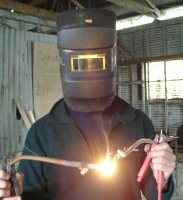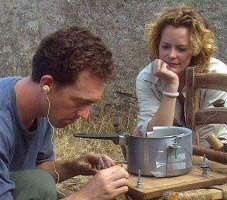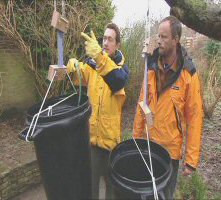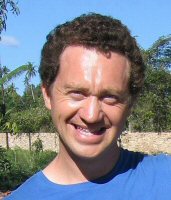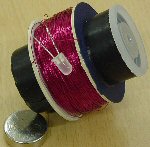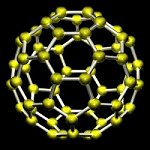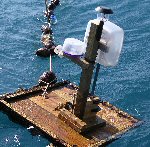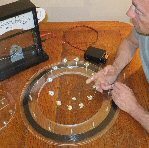Dr JONATHAN HARE - biographical notes
Visiting Outreach and Public Engagement Fellow in the Chemistry department at Sussex University (UK)
BACK TO MAIN SITE
one page summary of Jonathans work (doc)
I love making things. The process of 'making things' is often more important to me than the initial aim, because these aims may turn out to be incorrect (or perhaps wrongly thought out) but the making process can still lead you to discovery. 'Making things' also keeps me 'up to speed' and 'sharp' so helping to me to appreciate how things work. Making things is also all about possibilities. Science is a creative place to explore possibilities.
Although I did really well in physics its not because of a natural tendency to be good at it. I did / do well because I am very determined to try to understand the mistakes I seem to make ... this determination is worth all the bother when it gives you a glimpse of how something works.
To make things you don't have to be very good at anything, you just need to be determined ...
it really is worth it, ... there is a spirit to it, ... so please dont worry about being clever (or not being clever enough) just start making things and go from there.
...........................
click here to see Jonathans talks and workshops
click here to see activities in the UK and abroad
Jonathan is a freelance research scientist who's PhD work was on Buckminsterfullerene (C60) in the Sussex Fullerene Centre with Prof. Sir Harry Kroto (the 1996 Nobel Prize for Chemistry) at Sussex University, UK.
Jonathan is the Visiting Outreach and Public Engagement Fellow in the Chemistry department at Sussex University (UK) (he is also an Associate of the School of Mathematical and Physical Sciences at the University of Sussex).
He is currently self employed enjoying exploring teaching science to all ages as well as to pursue making all sorts of things.
At school Jonathan had reading and writing 'difficulties' but tended to learn quickly through diagrams, pictures and by playing with machines at home. He has always had a great desire to experiment and try to understand better the things around him. In particular his imagination has always been captured by electronics. As a schoolboy he worked Saturdays at GWM Radio (Worthing, UK) repairing a range of instruments and electronic apparatus as well as learning to work with a wide range, and type, of people. He has worked at the Time and Frequency section of the National Physical Laboratory where he built Time Standard apparatus, which may be still in use daily today (Jonathan was a Time Lord for a year !).
He achieved a First in Physics at Surrey and then went on to Sussex for his PhD work with Sir Harry Kroto. This work lead to a method of producing Buckminsterfullerene (C60) for which Sir Harry, Richard Smalley and Robert Curl were awarded the Chemistry Nobel prize in 1996. He made a direct contribution to this field (Fullerene Science) and have co-authored many scientific papers in leading journals. In 1999 Jonathan was awarded an ISI citation certificate for these achievements in the physical sciences.
Jonathan has designed, built, tested and installed apparatus and other equipment for many laboratories including the Sussex Fullerene Group (Sussex University), the National Physical Laboratory (NPL) and British Gas. He makes 1-2 (new to him) prototypes a week and has done since a teenager. Jonathan has also built equipment for TV including for example the CH4 series Superhuman and two of the BBC COAST series.
Jonathan has been involved with a number of TV programmes and series including 'Tomorrows World' and a 'Horizon' programme - 'Molecules with Sunglasses' and COAST. I have also co-produced 'Reflections of Science' programs for the VEGA Science Trust.
Jonathan is one of the scientist team members of the Rough Science TV series (where five scientists are set science challenges in remote locations). To date 6 series have been made on location in the Mediterranean, the Caribbean, New Zealand, Death Valley USA, Zanzibar (East Africa) and Colorado. Jonathan co-present, with Robert Lewellyn Hollywood Science a series exploring the myths and science of Hollywood action movies (the programs are used as 'thought experiments' to ask 'could you really do that?'). These programs have been produced by the BBC for the Open University - many have been transmitted worldwide via BBC World.
Jonathan was part of the BLAST planning team, an OU outreach activity aimed at using its BBC TV and other broadcast programs within workshops and talks. Here he devised workshop / teaching equipment for these activities including Mars Rover type buggies and recently windmills. All these devices were made to be as strong / durable as possible but also educationally flexible.
Jonathan originated the Creative Science Centre (CSC) (a small-scale project at Sussex University) in order to provide a unique experience of science through exploring, planning, designing and making things. Activities include projects, workshops as well as consultancy work. He has presented hundreds of talks and workshops. These activities involve schools, colleges, universities as well as other links within the community. His motivation is to use his skills to help people experience something of the scientific process. The activities are a healthy two-way process because he gets the opportunity to diversify his skills and share this experience with new people, while they get a unique opportunity to learn and play outside of the constraints of the normal educational system. It is his wish to be able to extend this work further throughout the community.
click here to find out what people say about Jonathan's CSC work
Jonathan loves making things. He tries to make at least one new design / invention a week and has done so since he was a teenager. He has spent many hours juggling and also practices meditation. These experiences have allowed him to uncover his own learning pace. Other interests include mountain trekking, longboarding (long skateboard), drawing and painting.
Most recent work has been with designing, building and testing exhibition apparatus and working exhibits for the SEPnet project. For example building wave tanks and wave powered electrical demonstrations, a large coil for demonstration of how electricity is produced by Faraday Induction. Most recent of all with the Newton Project and SEPnet are seven remakes of 17C apparatus used to demonstrate Newton's profound and ground braking work. This work consists of working models and equipment as well as articles written up for schools and teachers.
Jonathan regularly writes for magazines, science journals and papers, e.g. his On-Screen Science and Secrets of the Trade articles for the RSC's The Mole and InfoChem magazines. His writings have been used in the 21st Century Science Pilot - Resources (for Teachers) (Nuffield, Oxford and University of York, 2004 Edition) and also Key stage 3 course material for Heinemann Science.
published papers and articles
Jonathan's Thoughts about Maths in science
Jonathan (G1EXG) has been a licenced radio amateur since 1984.
Read his thoughts on the 80m band
May 2000 awarded a NESTA Fellowship.
Sept. 2002 awarded an Institute of Physics' Public Awareness of Physics Award
October 2006 made a Fellow of the Royal Society of Chemistry
2009 made Visiting Lecturer in Science Communication at Sussex University in Physics
Link to Guy Hayler page
click here if you need a publicity photo of JPH
click here if you need a publicity photo of JPH with apparatus (Rough Science 5, Zanzibar)
click here if you need a publicity photo of JPH and experimental antenna (photo: by Geoff Rowland)
... did I tell you that I love making things ?? !!...
GET MAKING THINGS !
Dr Jonathan Hare, E-mail: jphcreativescience@gmail.com
NOTE: Although none of the experiments shown in this site represent a great hazard, neither the Creative Science Centre,
Jonathan Hare nor The University of Sussex can take responsiblity for your own experiments based on these web pages.
THE CREATIVE SCIENCE CENTRE
home | diary | whats on | CSC summary | latest news
